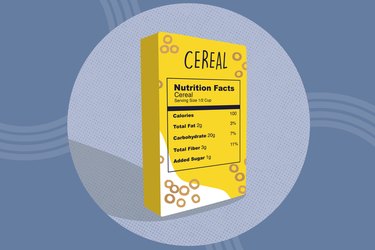
No matter what the colorful front of a packaged food promises — "gluten-free!" "all-natural!" "farm fresh!" — you'll only truly know if it's a good option once you turn it over to reveal the nutrition facts label.
But a lot of information gets packed into that tiny rectangle. So which parts of the label should be top priority? Is it more important that your pick is, say, low in sodium or low in sugar? Does that ranking change if you're trying to lose weight or have a chronic health condition?
Video of the Day
Video of the Day
For our Ask the RDs series, we asked readers to send us their biggest nutrition questions and then posed the 12 most common to a panel of registered dietitians. Here's what the experts had to say about reading nutrition labels and which nutrients you should always check.
What Are the Most Important Nutrients to Look at on a Nutrition Label?
"Although a serving is not a macronutrient, it is incredible information for people because it shifts that balance of what is on that label.
Before you even get into the protein, fat and carbohydrates, get an idea of how many servings are in there, because then you actually have to multiply if it's more than one serving.
We care a lot about protein, fat and carbohydrates, but I would put those into one category together. I would look first at servings, then I would look at protein, fat and carbohydrates based on your individual nutrition plan.
Knowing the protein, fat and carbohydrates is good information, but it's not imperative to your choices. Then, I would look at the added sugar content. For people with heart disease, people who are salt-sensitive or people with diabetes, I'd also look at sodium."
"If you're looking at the label from a weight-loss or weight-management perspective, the most important things to look at are calories first and then the serving size. If a package has four servings and you're trying to maintain or lose weight, you're going to want to make sure you're eating just one serving of whatever it is in that bag.
In some cases, you may need to use measuring cups to teach yourself a true serving. Then, depending on your dietary approach, that's when I'd look at the three macronutrients, which are protein, fat and carbohydrates.
Nutrition Facts, Decoded
Learn how to read nutrition labels and finally get your macros right.
If you're someone who feels best on a lower-carb diet, then, of course, you'd want to look at the carbohydrate amount. Does that amount on the label fit into your carb goals for the day?
You'd then want to look at the fiber. The fiber line is often under the carbohydrates, so if you're tracking net carbs, you'll want to subtract that fiber from the total carbs because they don't get absorbed the same way."
"What people really should be looking at is the nutrition label and the ingredient list, because just one of them does not tell the whole story — you have to look at them together.
In terms of what to look at on the label, it will vary. Some people might be more interested in the calories per serving. But I would recommend, in general, to look at added sugars versus total sugars, which now, happily, is on all packaged foods. You also want to look at protein, sodium and fiber."
"One of the most important things to look at is saturated fat. We should limit saturated fat to no more than 10 percent of our total daily calories.
Added sugars is the one we really want to look at over total sugars. Fruit has sugar and dairy has sugar, but they're natural sugar. So I always recommend staying under 5 to 7 grams of added sugar per serving.
Also look at sodium: It's recommended that the average person take in no more than 2,300 milligrams of sodium a day, so we definitely want to keep an eye on that throughout our entire day.
Then there's fiber. A food that's considered a good source of fiber has 3 grams per serving. Men need about 38 grams per day and women need about 25 grams a day. As far as macronutrients go, I would look at protein, carbohydrates and then fat. For micronutrients, I would look at sodium, calcium, vitamin D, iron and potassium."
The Takeaway
What you look at first on the nutrition label depends on your personal nutrition goals and health status, but in general the RDs recommend prioritizing serving size, calories, macronutrients (protein, fat and carbs), fiber and added sugars. Look for products with at least 3 grams of fiber and 5 to 7 grams (or less) of added sugars whenever possible. Also keep in mind daily limits for saturated fat and sodium: no more than 10 percent of your total calories and 2,300 milligrams a day, respectively.
Confused about nutrition? Get answers to more common questions in our Ask the RDs series.



